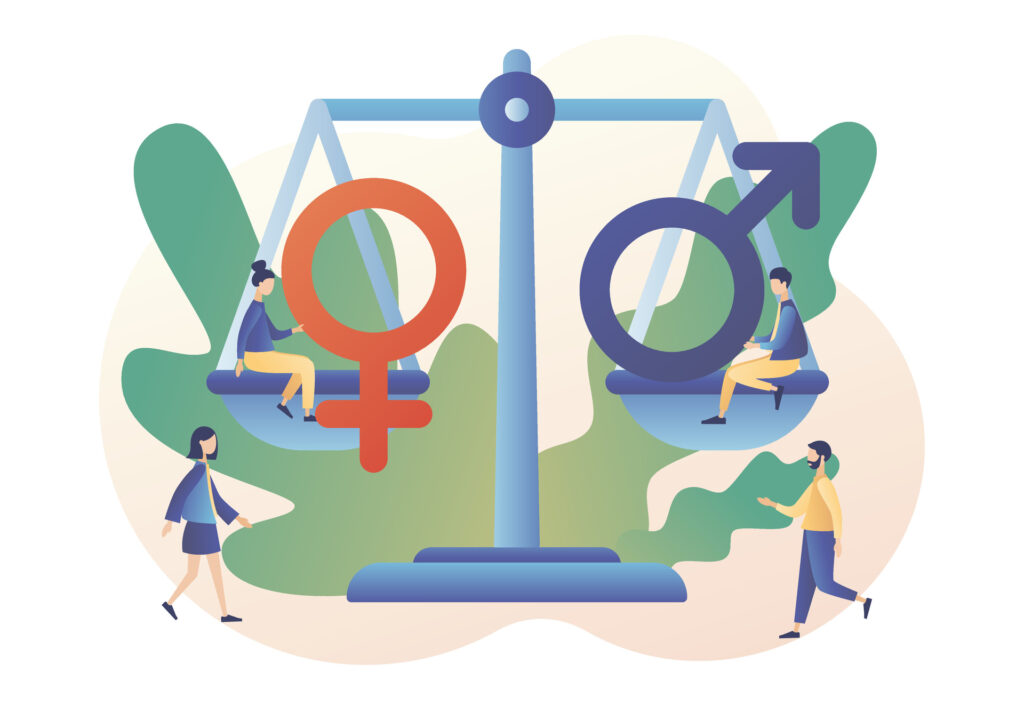
I wrote this article for catharsis and wanted to post it. Politics are messy. I usually see things as simple cause and effect, but people love to complicate them with emotion. (Yes, I’m emotional. No, the hypocrisy is not lost on me.) I have strong opinions, and I don’t find political debates enjoyable. But then I came across an article claiming women make poor leaders, backed by modern conservative arguments using grade school logic. It struck a nerve because, let’s be honest, there’s no real proof that one gender is better at leading than the other. Not speaking up would have made a statement, too. That said, I do like to see all sides before making up my mind.
History has shown us a variety of societal structures, some patriarchal, others matriarchal, each claiming their own set of strengths. This brings up the old question: which gender makes a “better” leader? Are women naturally more collaborative, whereas men excel in competitive environments? And do matriarchal societies actually perform better?
Research tells us the truth is far more complex. Leadership isn’t about gender; it’s about a unique mix of traits, styles, and context. From ancient empires to modern boardrooms, success comes down to adaptability, emotional intelligence, and situational awareness—not the leader’s gender.
Leadership Across History: A Look at Matriarchal and Patriarchal Societies

While the vast majority of societies are patriarchal, we have learned that they do not have to be. We’ve been privileged enough to experience both matriarchal and patriarchal hierarchies and to learn from both. Grass societies such as the Minangkabau in Indonesia or the Moso in China, for instance. These cultures have emphasized cooperation, community decision-making, and fair resource distribution throughout their history. Women have been key in governance and conflict resolution. They helped create social cohesion and stability. These societies often excelled at maintaining internal peace.
The Moso prioritized diplomacy and negotiation over aggression, reducing internal conflict despite not being entirely matriarchal. However, this non-militaristic approach sometimes left them vulnerable to external threats. The Minoans, known for their peaceful and cooperative nature, struggled to compete with more aggressive patriarchal neighbors, which ultimately contributed to their downfall.
On the flip side, we have far more data on patriarchal societies, which have dominated much of recorded history. They emphasize hierarchical structures, centralized power, and military conquest. Empires like Rome, Greece, and Egypt grew through significant conquest and territorial expansion. They developed complex bureaucracies. Patriarchal leaders sought to dominate territory and grow economies. This led to great advances in technology, culture, and the economy. Ancient Rome, for instance, became one of history’s largest empires, built on military strength and an organized government.
But it’s not all sunshine and roses for patriarchal systems. They grappled with internal inequality and power struggles on a regular basis, leading to their eventual collapse. When a few men merge power, they often create rivalries and civil wars that destabilize empires. Ancient Egypt saw many dynasties fall due to betrayal and coups. The Roman Empire, if you may recall, fell due to corruption, overexpansion, and internal unrest.
So, what does all this mean? To me, it suggests that our real challenge isn’t about gender or ideology (whether conservative or liberal) but rather about achieving balance. Leadership transcends the binary of patriarchal and matriarchal structures, advocating for the integration of diverse perspectives. Blending qualities traditionally associated with men and women can create a more dynamic and resilient system. Just as a scale requires equal weights to maintain equilibrium, effective leadership thrives when different strengths, ideas, and approaches are harmonized, leading to comprehensive and inclusive decisions that better address modern challenges.
Men often embody traits similar to the sympathetic nervous system, marked by action and adrenaline, while women reflect the parasympathetic system, promoting rest and nurturing. Both systems are essential; the sympathetic system enables quick responses in crises, while the parasympathetic fosters long-term well-being. This balance of assertiveness and compassion cultivates a holistic approach to problem-solving, creating an environment where urgency and empathy coexist harmoniously.
Modern Studies on Leadership: Style Over Gender

Modern psychology and sociology have unveiled a more nuanced understanding of leadership: the qualities that define great leaders extend beyond gender. This shift is essential as we pursue a more inclusive world—one that benefits everyone in tangible ways. When leadership reflects the diversity of the people it serves, it leads to effective policies, workplaces where individuals feel seen and heard, and communities thriving on shared strengths. This all translates to better schools for our children, decisions that serve out of a sense of need, not greed. Inclusivity is not just fair play, a right to be heard or taken seriously; it is the path to a world in which we all have an equal stake in the future.
One of the areas in which women are often strong is transformational leadership: an energized and hopeful style that is about more than simply managing teams but inspiring them, encouraging innovation and personal development. Transformational leaders encourage followers to go beyond their own self-interest in order to advance the greater good. They often embrace relationship-building and collaborative decision-making, creating warm, open working environments where people can share ideas. This style is best suited to organizations in fast-paced tech and dynamic creative industries, where adaptability is key.
Companies led by transformational leaders often see higher employee satisfaction and retention. When team members feel valued and engaged, loyalty blossoms, infusing the workplace with enthusiasm and ultimately boosting productivity. In such dynamic environments, everyone can thrive. Transformational leadership nurtures individual potential and cultivates a culture of innovation that benefits the entire organization.
On the flip side, men have often been linked to transactional leadership, a style that brings order and structure to the workplace. Characterized by clear hierarchies and defined roles, this approach emphasizes reward systems and goal-oriented management. Transactional leaders thrive in competitive arenas where performance metrics are paramount, such as finance, sales, and the military. Imbued with a focus on efficiency and achieving task-related outcomes, this approach can be powerful, especially in crisis situations, offering concrete focus in a fog of confusion. Studies suggest that men are more likely to adopt a directive leadership style, manifesting through confident assertions of authority and rapid decision-making. While this approach drives immediate action, ensuring goals are met, it can also create a rigid atmosphere that stifles creativity.
But sticking rigidly to outdated leadership models doesn’t help anyone. Both men and women can adopt whatever style the situation demands. It’s about playing to strengths, reading the room, and knowing when to use which style. A woman in a male-dominated field might want to walk on the aggressive side to make her mark; a man who runs a creative team might find a more inclusive approach works better. The common factor in effective leadership is knowing when to change gear.
This is where inclusive leadership comes in, a mix of transformational and transactional styles that defies the old dichotomy. It means that you’re open to hearing from all sides, and that you’re building an environment, one where everybody feels like they can come to the table. When leaders get there, the result is gold: teams are more innovative, they solve problems more quickly, and engagement soars. Not just good business, it’s necessary business, because the world is changing faster every day.
Why should you care? If you’re a founder of a start-up, or a leader of a team, or just someone wanting to make a difference in your community, being attuned to these nuances can be transformational. Skills of emotional intelligence are essential leadership tools; when leaders can manage their own emotions and respond to others’ emotions with empathy, leading to a greater ability to build trust, resolve conflicts and create resilient teams.
After all, great leadership is not about gender – it is about being more attuned to the needs of the moment and being adept and responsive enough to flex your game. And as we continue to see companies value diversity and inclusion, it is not just helpful to understand these dynamics – it is essential. The future of leadership is about being open-minded, flexible and embracing the best of human ingenuity and potential, wherever it is found. If we get that right, we’re not just building better businesses or governments, we’re building a better world.
Group Dynamics and Leadership: Lessons from Psychology

If you’ve ever seen a group project spiral into chaos, you’ve got a front-row seat to the reality of leadership dynamics. The messy truth is that leadership is about the context, the group, and the strange alchemy of human interaction. Studies like the Stanford Prison Experiment show how fragile our sense of order is when power and group identity are at play.
Before Lord of the Flies, Muzafer Sherif and colleagues conducted a study of boys at a summer camp. Two groups of boys were isolated and told to compete against each other. Almost immediately, hostility and tribalism exploded. In 1971, The Stanford Prison Experiment, led by psychologist Philip Zimbardo, offered a real-life glimpse into how power can corrupt, turning ordinary people into monstrous figures. In a mock prison, college students cast as “guards” mistreated their fellow “prisoners.” They slipped into their roles and ignored their morals. The experiment was set to run two weeks, but had to be cut short after six days because it got so out of hand.
It’s the perfect example of how group identity can ignite conflict in a short time—and how leaders can easily stoke or quell that fire. Studying is a potent lesson. Effective leadership isn’t only about resolving conflict when it arises, it’s about heading it off at the pass by understanding and managing group dynamics.
But why should you care about any of this? Because it’s all around you. Politics doesn’t just refer to government; politics is one’s ability to get along with others. “This world in arms is not spending money alone. It is spending the sweat of its laborers, the genius of its scientists, the hopes of its children.” Eisenhower’s worries have come to pass. We monetized war, and politics became about who had the biggest stick rather than one’s ability to be a diplomat. Politics surround us in leading a team, organizing a community event, or navigating family politics. Leadership isn’t just about barking orders or making big decisions, though it can be. It’s about reading the room, understanding the hidden power plays, and knowing when to step back or push forward.
Such dynamics can be especially damaging for women in leadership positions, who are often caught up in the ‘double bind.’ Lean too far into strength and you are judged as too aggressive; lean too far into empathy and collaboration and you risk being perceived as a pushover. Here, the energy needed just to stay in the game is siphoned off from the energy needed to lead well. Men, on the other hand, often get more leeway. A male leader can be nurturing or directive, and either way, he’s seen as competent. But the deck isn’t stacked equally.
This isn’t theoretical: it’s happening now, every day in every enviroment, which is why we need to move beyond our ideas of what leaders’ should’ look like. Leadership is about much more than lofty charisma or a big voice. It’s about adapting to the context. It’s about using everyone’s strengths. And, it’s about managing group identity and power dynamics.
Once we understand these concepts, we can start creating better teams, making smarter decisions, and creating more productive environments. Places where everyone thrives. Because, in the end, leadership isn’t about the title. It’s about performance.
Politics and Power: Why Gender Is Not the Determining Factor

Political leadership might rest in a certain office – but it’s more than that, too: it’s also about trying to steer a ship of state through an atmospheric vortex of high hopes, low expectations, old prejudices, and new distractions. Women have proven themselves to be not only competent leaders but also just as capable as their male counterparts. Angela Merkel, Jacinda Ardern, and Ellen Johnson Sirleaf are just three modern leaders. But the world’s most powerful women aren’t just powerful: they are, to varying degrees, confronting the fact that power isn’t handed to them on a plate but has to be won in environments that are often hostile towards their capacities; and that, for all the recognition they might receive, it’s often the sharpest criticism they endure that comes from the belief that they fall short of expectations – expectations that seem to be less to do with their actual performance and more with societal norms of how female politicians ought to behave.
Angela Merkel, for instance, in her modest jacket, standing at the center of the German state for 16 years, steering a country through crises that would have unhinged most leaders. Not just political crises – such as the Eurozone crisis or the refugee crisis – that were also emotional minefields. Merkel spoke in measured, usually defensive, tones and she has been dubbed by the press as ‘Mutti’ (mother) for this. But when she let thousands of refugees into Germany in 2015? This was a human decision that seemed to enshrine decency itself in the shape of a woman’s body. The response was brutal: she was held responsible for what happened to Germany, for the rise of the far Right and xenophobia, for endangering the core of Germany’s identity. Empathy, even when mediated by rationality and necessity, is always in danger of becoming a political football.
Then there is Jacinda Ardern, whose generous smile and direct gaze came to symbolize optimism and goodwill during New Zealand’s darkest hours. Her response to the Christchurch mosque shootings and the COVID-19 pandemic – her very way of leading – was the subject of international headlines. It was admired for being a rare combination of strength and compassion. But listen closely, in the muted voices of domestic newspaper opinion pages and social media posts, and there is a very different story told. Her economic policies were poor; her COVID lockdowns squashed the life out of the country; and her resignation over burnout was almost surreal – as though the extreme demands of empathy and leadership had finally crushed her. It all feels like a vivid metaphor for how the qualities that make leadership soar can also be the very qualities to crush a person in the glare of extreme scrutiny.
Then there is Ellen Johnson Sirleaf, Africa’s first freely elected female head of state, a small woman with a big voice who strode through the devastated streets of wartorn Liberia, attempting to right a ship shattered by years of war and the deadly Ebola epidemic. She was a lifeline, yet during her reign, she found herself accused of nepotism and corruption. The charges seemed to choke her with weeds, trying to entangle her remarkable story. Even the wisest leaders can stumble and find themselves trapped in the delicate balancing act of politics, where one wrong move resonates like a creaking floorboard.
And not just women, but every leader makes their gambles. They choose, and there is no assurance that any choice is the right one. Winston Churchill and Franklin D Roosevelt were both lionized as they navigated their countries through war, bringing them to the other side. But not everyone fared as well in the aftermath. Churchill’s imperialist policies; Roosevelt’s internment of Japanese Americans during World War II are visceral issues for many people to this day. Leadership is not just about strength, or even success, it is about the wake left by those decisions. It is about the power that ripples outward, the ways that decisions follow a leader, affecting people through the course of history.
The reality is that good leadership is a messy, multivalenced, multifaceted business that is forged in the heat of crisis, tempered in the fires of criticism and, often, measured through the murky lens of public opinion. And, for women in power, this is doubly true, not just because they are judged less on the substance of their policies and more on their style, but because their ability to strike the right balance of empathy and authority is ever more lazily (and often sexistly) judged against a set of feminine stereotypes. It’s a tightrope that women in power walk on, strung high above the pit of stereotypes in which one misstep means certain death.
Why does it matter? Because it’s complicated and worth paying attention to. It’s not just a matter of male or female but of layers of context, expectation, and prejudice. It’s a challenge to your own assumptions and a rallying cry for a leader and a board as diverse as the citizens they serve. If we want leaders who aren’t just male or female but a whole spectrum of other diverse and interesting things, then we’re going to have to pay attention. And we’re certainly going to have to see beyond the binary. Only then will we be able to move beyond the one-note narrative?
Conclusion: The Power of Leadership, Not Gender

At the end of the day, asking whether men or women make better leaders misses the point entirely. It simplifies a complex and nuanced topic that’s driven by a mix of factors like context, personality, and strategy that shape effective leadership.
Matriarchal societies show the value of inclusive, cooperative leadership. Patriarchal systems highlight the strengths of hierarchical governance. Each model has its ups and downs, and neither is inherently better just because of gender. But what if we flipped the script? Instead of one leader, maybe there should be two. They would need to be running mates whose views oppose one another, but with an ability to compromise. Imagine the balance of views that two individuals could bring. Each has their own strengths. This duo could improve decision-making and representation. They could then better address their teams’, organizations’, or nations’ diverse needs.
In the end, the best leaders, no matter their gender, are the ones who can adjust their style to fit the situation. The future of leadership isn’t about picking sides; it’s about nurturing the skills and qualities that lead to success in any environment. By embracing this mindset and the power of dual leadership, we can create a new generation of leaders. They will reflect the rich tapestry of our world.








